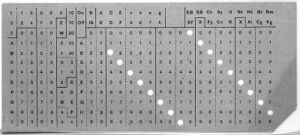Hollerith card (nonfiction): Difference between revisions
No edit summary |
|||
| (5 intermediate revisions by the same user not shown) | |||
| Line 12: | Line 12: | ||
Use of the ticket punch proved tiring and error prone, so Hollerith invented a [[pantograph (nonfiction)]] "keyboard punch" that allowed the entire card area to be used. It also eliminated the need for a printed template on each card: a master template was used at the punch; a printed reading board could be placed under a card that was to be read manually. | Use of the ticket punch proved tiring and error prone, so Hollerith invented a [[pantograph (nonfiction)]] "keyboard punch" that allowed the entire card area to be used. It also eliminated the need for a printed template on each card: a master template was used at the punch; a printed reading board could be placed under a card that was to be read manually. | ||
== In the News == | == In the News == | ||
<gallery mode="traditional"> | <gallery mode="traditional"> | ||
File:Paper_tape_relay_operation.jpg|link=Unexpectedly Hanging Chad|Documentary film ''[[Unexpectedly Hanging Chad]]'' is surprise hit at electoral policy conference. | |||
</gallery> | </gallery> | ||
== Fiction cross-reference == | == Fiction cross-reference == | ||
== Nonfiction cross-reference == | == Nonfiction cross-reference == | ||
Latest revision as of 08:15, 7 May 2017
A Hollerith card ("punched card", etc.) is a piece of stiff paper that contain either commands for controlling automated machinery or data for data processing applications.
Both commands and data are represented by the presence or absence of holes in predefined positions.
Herman Hollerith was awarded a series of patents in 1889 for mechanical tabulating machines. These patents described both paper tape and rectangular cards as possible recording media.
The card shown in U.S. Patent 395,781 of June 8 was preprinted with a template and had hole positions arranged close to the edges so they could be reached by a railroad conductor's ticket punch, with the center reserved for written descriptions.
Hollerith was originally inspired by railroad tickets that let the conductor encode a rough description of the passenger:
"I was traveling in the West and I had a ticket with what I think was called a punch photograph ... the conductor ... punched out a description of the individual, as light hair, dark eyes, large nose, etc. So you see, I only made a punch photograph of each person."
Use of the ticket punch proved tiring and error prone, so Hollerith invented a pantograph (nonfiction) "keyboard punch" that allowed the entire card area to be used. It also eliminated the need for a printed template on each card: a master template was used at the punch; a printed reading board could be placed under a card that was to be read manually.
In the News
Documentary film Unexpectedly Hanging Chad is surprise hit at electoral policy conference.
Fiction cross-reference
Nonfiction cross-reference
External links:
- Punched card @ Wikipedia

